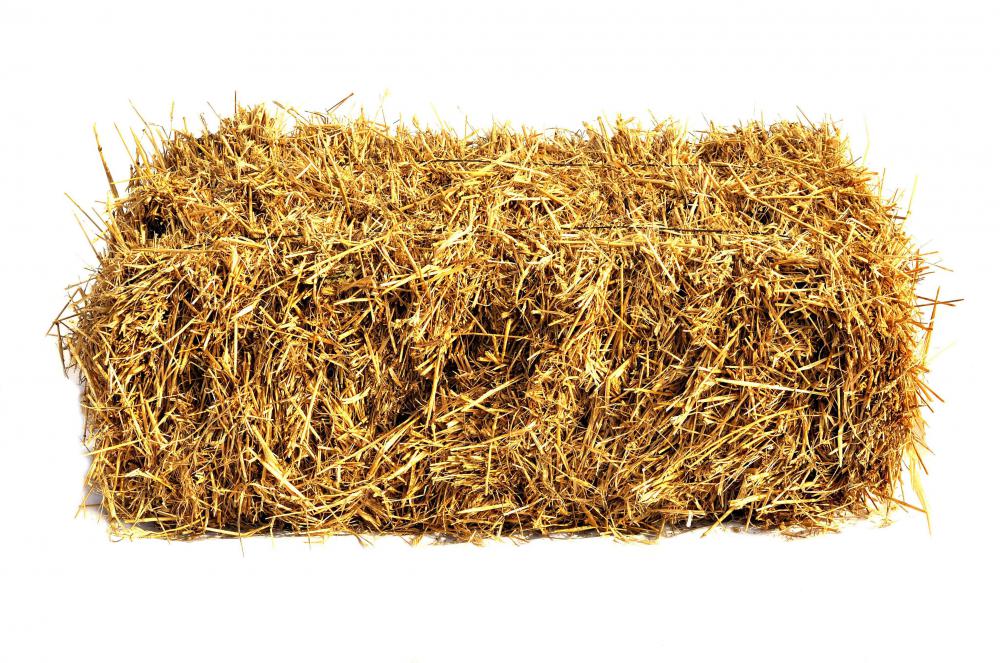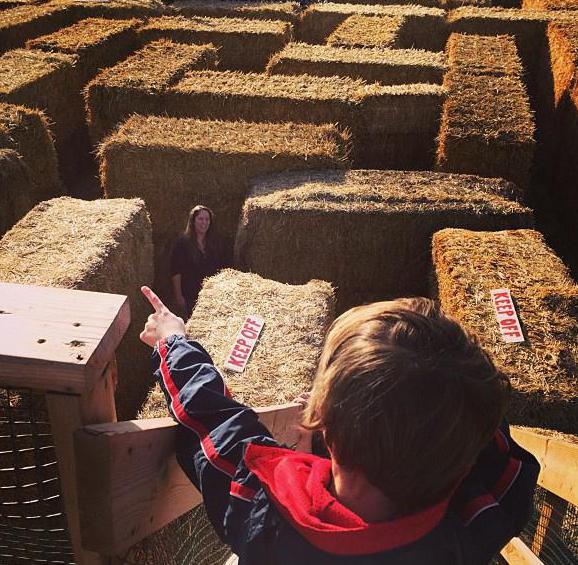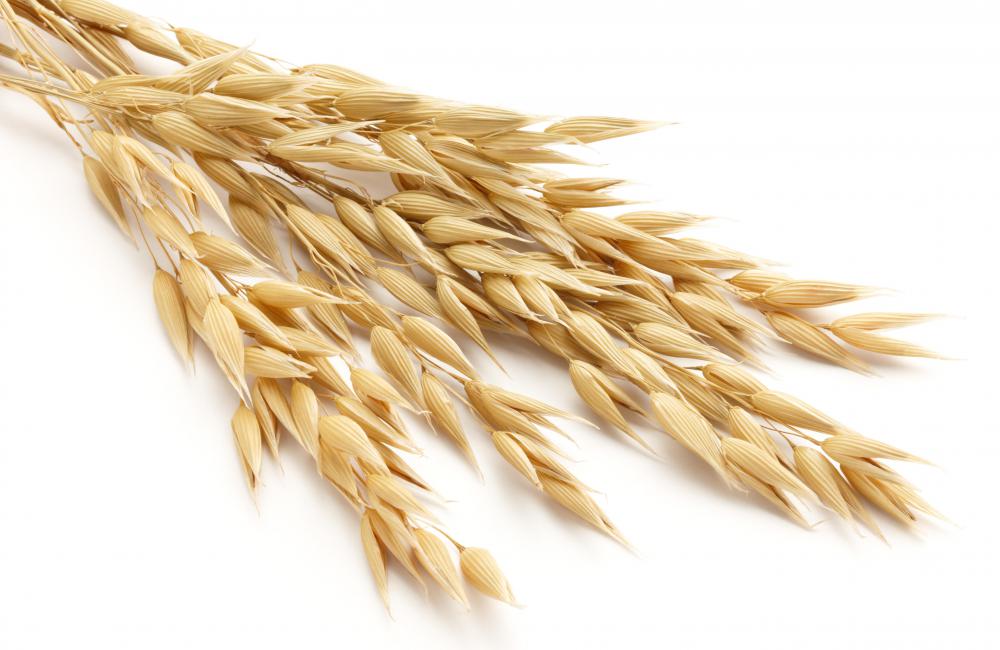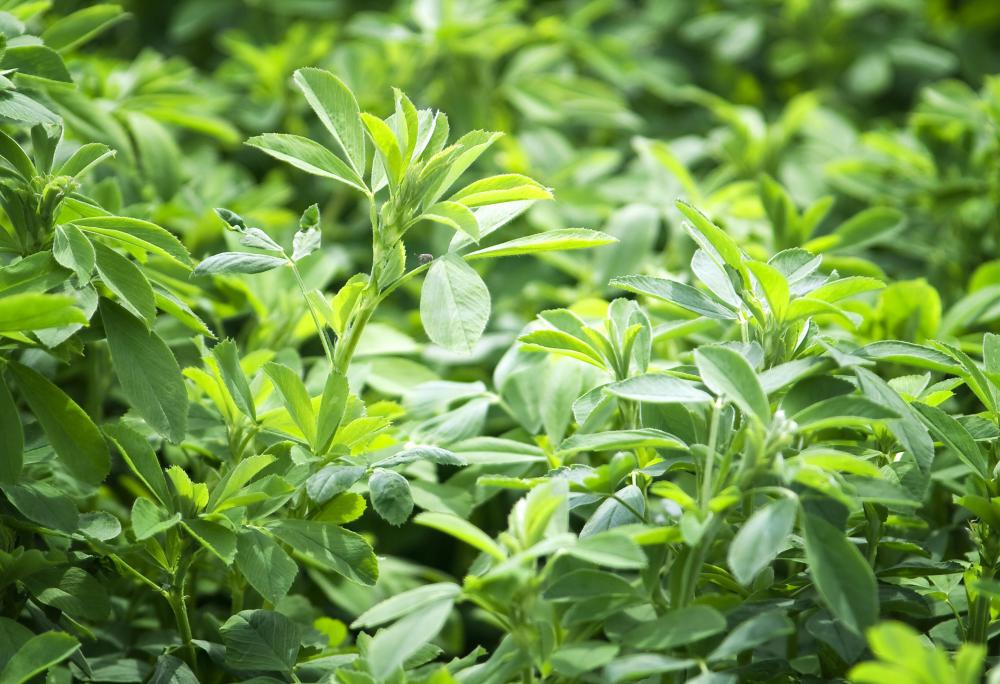At HomeQuestionsAnswered, we're committed to delivering accurate, trustworthy information. Our expert-authored content is rigorously fact-checked and sourced from credible authorities. Discover how we uphold the highest standards in providing you with reliable knowledge.
What is Hay?
Hay is the general name for a number of dried grasses, flowers and other plants used as off-season food for horses and other animals. Producers usually grow rye grass, oats, or alfalfa in large open fields and wait until the leaves have reached a specific maturity, generally just before their flowering stage. The grasses or plants are then cut with machinery and left to dry on the ground for several days. At this stage, excessive rain may be problematic. Some hay growers will turn the cut grass over for more even drying, a process called tedding.
Once the grass or alfalfa has dried sufficiently, it is gathered up mechanically by a machine called a baler. The rear section of the baler creates rectangular or round bales of hay held together by wire. These bales are left in the field until other laborers can collect them. The traditional rectangular bales are generally stored in special barns called haymows or hay lofts. Modern round bales are usually stacked together in a dry outdoor location and covered with a special plastic tarp for weather protection.

Fresh hay bales continue to dry in place for several months. Because the bales are relatively heavy, compression force may help the bottom of the bales dry even faster. One problem farmers face is the excessive heat generated by the compression of wet grass in the center of the bales. For this reason, most haylofts in barns are airy and open. If the hay is stored in unventilated areas, the excessive heat could actually cause a fire in the loft.

During winter months, or in areas where fresh grass is not readily available, ranchers and farmers typically rely on hay to feed their horses. It is not always as nutritional as regular feed, but it does have enough vitamins and roughage to keep animals healthy for a few months. It might help to think of it as a form of granola or breakfast cereal for horses. Some hay supplies may rot or ferment, rendering them useless for feed but ideal for garden mulch.

Since rye grasses and alfalfa continue to grow throughout the year, hay producers may be able to cut the same field up to three times before the winter freeze. This can prove beneficial for the local farmers and ranchers, since supplies can run dangerously low at times. Some hay sold as emergency or low-cost feed can lead to malnutrition and other problems, so producers who can provide high quality bales in bulk are usually very popular in agricultural circles.
AS FEATURED ON:
AS FEATURED ON:















Discussion Comments
@shell4life - I live in the Midwest and there are a lot of hay rack rides every fall. People sit on bales of hay and are pulled around by hay wagons through the fields or from place to place.
If you live in the city, there is something very refreshing about going to the country, sitting on a hay bale and breathing in the cool, crisp air.
These hay rides are usually followed by some good food and hot drinks around the campfire. These hay rides are always a fun activity that our whole family looks forward to.
@myharley - The weather really is crucial when it comes to the quality of hay. It also plays a big part in the price it is sold for.
In some parts of the country where they have gone for months without rain, this also means they have run out of hay to feed their livestock.
One of our friends sold hay to people several states away because they could not find it close to where they lived. This really drives up the price of the hay.
This can be a good thing for the person selling it, but not so good for the people who have to buy it.
She lets the rest of the grass grow, and another neighbor drives over and makes hay out of it. He uses this hay for horses and livestock.
He makes this into the big round bales of hay instead of the smaller square ones. You have to make sure you have all the right equipment when it comes to the size of bales you want.
Last year we had such a wet summer that he was only able to get two cuttings from this grass and I don't think the quality was nearly as good as it was in past years.
Baling hay is hot, hard work. Even though the machines make the bales, people usually have to load the bales on the trailer.
We bale hay to feed our horses in the winter, and everyone in the family pitches in to help. If the weather is good, we can get three cuttings from one field in a season.
Watching the weather for upcoming rain is crucial when it comes to putting up hay. It is always best if you know you are going to get a few days of hot, dry weather.
While eating hay is never as good as fresh, green grass, our horses do like a fresh bale of alfalfa hay.
One thing you have to watch out for when storing your hay is that it doesn't get moldy. Not only does this ruin your hay, but can also make the horses sick if they eat it.
I like to use the hay that forms after I mow my yard as mulch. I have a tendency to wait until the grass gets pretty high to mow it, so I have more hay than most people.
I let it lay around on the lawn for a few days to dry out. Then, I gather it in buckets and use it around my flowers and strawberries. It is excellent at keeping weeds from popping up, and it even keeps the grass from invading the area as quickly.
The only problem is that sometimes, the seeds from the dead grass are still viable, and they will reseed in these areas. When this happens, I yank up the seedlings as soon as I see them, because once they are established, they will spread and be hard to eliminate.
@OeKc05 – I think a lot of kids that live out in the country come up with fun activities involving hay. Sometimes, the adults get in on it, too.
I don't know if this is common everywhere, but I grew up in the South, and every fall, several churches and farms in the area would offer hay rides. A trailer pulled by a tractor would be filled with rectangular bales of hay, and people would pile up on them and get carted down a trail.
Many times, the rides were held at night, and someone would jump out from a ditch or from behind a tree to scare the kids. Hay rides were often Halloween related, so this was normal.
I lived near a farm as a kid, and I developed the sport of hay jumping with my cousins. Our neighbor had the huge round bales all stacked together in rows, and he let us play on them.
Since they were held together by wires, we didn't do any harm while jumping from bale to bale. It was a little dangerous, because we were about five feet up in the air, but the bales were stacked so closely that there wasn't much risk of falling.
Now that I'm grown, I miss hay jumping. I've been tempted to go out and buy some hay bales of my own, but I would feel pretty silly out there now.
My neighbor has a large field of grass that he lets grow all summer long. He doesn't have any livestock out there, so it is unimpeded.
In October, he goes out there with a big tractor and cuts it all down. About a week later, he takes a baler out there. I saw him at work for the first time last fall, and it was pretty cool.
The baler would go across a small section of grass, and then it would stop. I couldn't see what it was doing until a large bale of hay fell out of the rear of the baler. It then moved on to the next section, producing bales every few yards.
I had always wondered how hay bales were made, and it was revealed to me in that moment. The machine made it seem so easy.
Post your comments